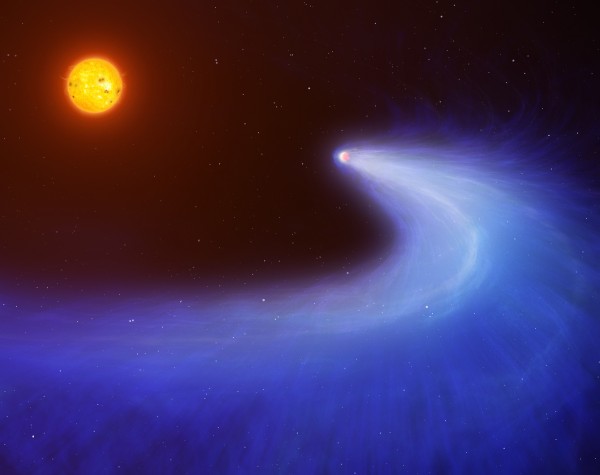Red Dwarf Burns Off Planet’s Hydrogen Giving It Massive Comet-Like Tail

Mark Garlick/University of Warwick A large cloud of hydrogen gas absorbing the light from a red dwarf star as its exoplanet, GJ 436b, passes in front. The cloud is created as of result of x-rays emitted from the red dwarf burning off GJ 436b’s upper atmosphere
Depicted in an image by Mark Garlick and issued by the University of Warwick, it has been suggested that low-mass exoplanets orbiting close to their parent stars could have had some fraction of their atmospheres ‘burnt off’ by extreme irradiation from the star, but confident measures of such losses have been lacking until now.
Commenting on the visual depiction Dr Peter Wheatley, from the University of Warwick’s Astronomy and Astrophysics Group and one of the research’s co-authors, said that:
“What we can see is a large cloud of hydrogen gas absorbing the light from a red dwarf star as its exoplanet, GJ 436b, passes in front. The cloud is created as of result of x-rays emitted from the red dwarf burning off GJ 436b’s upper atmosphere.
“The cloud forms a comet-like tail as a result of ultraviolet light coming from the star pushing on the hydrogen and causing it to spiral outwards.
“Around 1000 metric tonnes of hydrogen are being burnt off from GJ 436b’s atmosphere every second; which equates to only 0.1% of its total mass every billion years. The same process is likely to be much stronger on other exoplanets, where the entire atmosphere could be removed or evaporated to destruction”.
Dr Wheatley led the x-ray observations used to trace the heating of the GJ 436b’s atmosphere.
Notes:
• The research, A giant comet-like cloud of hydrogen escaping the warm Neptune mass exoplanet GJ 436b, is published by Nature.
• The research was led by Dr David Ehrenreich of Observatoire de l’Université de Genève.
• Picture free to use with credit to Mark Garlick/University of Warwick.
Contact Information
Tom Frew
International Press Officer
a.t.frew@warwick.ac.uk
Phone: +44 24 765 75910
Media Contact
More Information:
http://www.warwick.ac.ukAll latest news from the category: Physics and Astronomy
This area deals with the fundamental laws and building blocks of nature and how they interact, the properties and the behavior of matter, and research into space and time and their structures.
innovations-report provides in-depth reports and articles on subjects such as astrophysics, laser technologies, nuclear, quantum, particle and solid-state physics, nanotechnologies, planetary research and findings (Mars, Venus) and developments related to the Hubble Telescope.
Newest articles

Properties of new materials for microchips
… can now be measured well. Reseachers of Delft University of Technology demonstrated measuring performance properties of ultrathin silicon membranes. Making ever smaller and more powerful chips requires new ultrathin…

Floating solar’s potential
… to support sustainable development by addressing climate, water, and energy goals holistically. A new study published this week in Nature Energy raises the potential for floating solar photovoltaics (FPV)…

Skyrmions move at record speeds
… a step towards the computing of the future. An international research team led by scientists from the CNRS1 has discovered that the magnetic nanobubbles2 known as skyrmions can be…





















